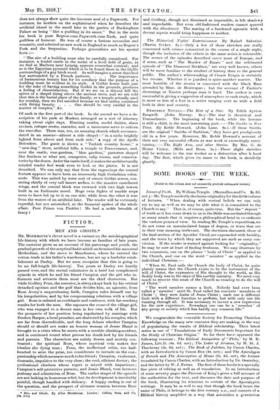PARTERRES AND FOUNTAINS.*
IT is strangely refreshing after nearly four years of war to breathe once more the atmosphere of moss houses, sham cascades, and bogus ruins. Readers and admirers of the works of " Amenity " Repton, of his not less remarkable predecessor Papworth (author of that celebrated essay on the dry-rot), or of the great Loudon, will not fail to welcome the present volume. It is a somewhat surprising production. Was Repton—to whom the first volume of this series was devoted—nsed in the same spirit ? For the 'editor of Prince von Ptickler's outpourings has treated his author aux - - plus grand serieux. In all good faith, and on fine thick paper,
with all the embellishments of numerous plates," " folding plans,"
copious notes," and an index, are the beauties of this Prussian Papworth displayed to the reader.! Not once apparently does the tongue of the editor seek the shelter of his cheek. The reader breathlessly peruses the Introduction. No, there are all our dear old friends—hints on the avoidance of a browsing line, -the correct management of islands, the concealment of park boundaries, proper methods of making an artificial waterfall, all treated with the most perfect gravity and decorum ! Prince von Piickler was a German, rich, and the owner of a huge. estate.in Silesia which he ultimately embellished on so vast a scale as to be obliged- to sell every acre of it. He was born in 1785 and died in 1871. Let not these dates alarm, the reader. True, he was occasionally a little late. He • Hints on Landscape Gardening. By Prince" von Pickier ?Linehan.. Edited bl Samuel Persona (Pubtlehed under the auspices of the American Society of Land *cape Architects.) London : uoughtea„ Mas, and CZ [161.,
does not always show quite the innocent soul of a Papworth. For instance, he borders on the sophisticated when he describes the artificial island in the small lake in the garden of Buckingham Palace as being " like a pudding in its sauce." But in the main his book is pure Repton-cum-Papworth-cum-Nash, and quite guiltless of humour. He was of course a furious naturalist• and romantic, and admired no new work in England so much as Regent's Park and the Serpentine. Perhaps generalities are his special forte The site of a building must also be carefully considered. Fig instance, a feudal castle in the midst of a level field of grain, as we find at Machern near Leipsig, appears somewhat comical; and so is the Egyptian pyramid which is to be found there in the idyllic surroundings of a gay birch wood. As well imagine a straw thatched but surrounded by a French parterre. . . . The importance of harmonious beauty has for its corollary that the purpose of a building must be evident in its style. A Gothic house built just for the sake of having something Gothic in the grounds, produces a feeling of dissatisfaction. But if we see on a distant hill the spires of a chapel rising above the ancient trees, and we are told that this is the burial-place of the family, or a temple actually used for worship, then we feel satisfied because we find utility combined with fitting beauty. . . . One should be very careful in the matter of temples,". &c.
Of such is the first part of the book. In the second we have a de- scription of his park at Muskau arranged as a sort of itinerary taking about eight days. Hunting castles, model dairies, sham ravines, cottages orntes, cascades, and a racecourse serve to enliven the traveller. There was, too, an amazing church which accommo- dated in an annexe—almost a side chapel—" in a niche brightly lighted from above and from each side," a copy of the Apollo Belvedere. The guest is shown a " Turkish country house," a " new-dug !' river, artificial hills, a temple to Perseverance, and, near the castle, rose-gardens, " blue gardens," parterres shaped like feathers or what not, orangeries, tulip rooms, and conserva- tories by the dozen. As for the castle itself, it makes the architecturally minded reader feel weak even to look at the plates. It is not described. We can only say that from the engravings the central feature appears to have been an immensely high Corinthian colon- nade. This was united by some sort of ornate Gothic screen, con- sisting chiefly of very tall lancet arches, to the massive castellated wings, and the central block was crowned with two high towers built in an Italianate mood. Huge twin flights of marble steps seem to have led up to it on one aide, while from the other it rose from the waters of an artificial lake. The reader will be extremely regretful, but not astonished, at the financial upshot of the whole affair. Poor Prince von Ptickler ! He had a noble breadth of fancy I



























 Previous page
Previous page